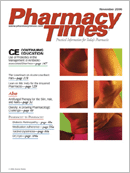Publication
Article
Pharmacy Times
Medicating Enteral Tube Patients at Home
Author(s):
With health care being deliveredin the most cost-effectivemanner possible, manypatients are discharged to home with anenteral feeding tube. Surgeons will insertmore than a quarter million temporary orpermanent feeding tubes in the UnitedStates in 2006.1 Many patients themselves,long-term care staff members,and visiting nurses will rely on pharmacists' advice to keep these patientsadherent and ambulatory.2,3
Feeding tubes provide nutrition andhydration when patients cannot swallowor should not eat. Unlike parenteral nutrition,enteral feeding stimulates mesentericblood flow and gastrointestinalsecretions and may improve immunedefense.4,5 Of the enteral tubes, percutaneousendoscopic gastrostomy (PEG)tubes are preferred. They are more comfortablethan nasogastric (NG) tubes,because they are located in the abdomenabout the belt line, and they lowerthe likelihood of aspiration.6,7
Regardless, enteral tubes invite controversy.Median survival among patientswho have permanent feeding tubes isabout 7 months, and mortality at 3 yearsapproaches 80%.8 When patients or theirfamilies are ill-equipped to handle formula-related diarrhea, constipation, orclogged tubes, nutritional status will notimprove.9,10 Patients with cognitiveimpairment often pull tubes out, complicatinghome care.8,11
The Mechanics
In enteral tube terminology, the initialsdescribe where the tube's terminal tipslie. Thus, an NG tube begins at the noseand ends in the gastric area, an NJ tubegoes from the nose to the jejunum, and aPEG tube is inserted through the skin intothe gastric lumen.12 Bolsters anchor thetubes internally and externally, but thetubes can move.
Most tubes are now polyurethane orsilicone, because polyvinyl chloride (PVC)tubing must usually be replaced frequently.PVC also may react with some drugs orleach into the acidic gastric environment.Similarly, latex tubes are more fragile andcan cause an allergic reaction. PVC andlatex tubes are more likely to occludethan polyurethane tubes.12
Blockage is a constant concern withfeeding tubes, and clog prevention is thebest approach. Intermittent feeding withliberal flushing tends to cause fewerblockages than continuous feeding.Patients or caretakers must always flushtubes frequently with 3 to 6 oz of waterand put only substances of minimal viscosityinto the tube. Allowing formulabags to empty in place, using long tubinglengths or small diameters, and administeringmedications improperly also promoteclogging.13,14
If possible, obstruction should be disruptedwith the tube in place; otherwise,the patient will need a new tube. Variousexperts have developed obstruction-removalprocedures and devices, butthey disagree about the best practice.Solutions of pancreatic enzymes, verydilute dishwashing liquid, cola, or meattenderizer have been employed, as havecytology brushes and corkscrew-typedevices.15,16
Medication Via a Tube
The enteral tube also is often a medicationconduit. Most tubes will have amain infusion port for formula delivery.Smaller side ports deliver fluid and medication,and a "balloon port" inflates theinternal anchor. Patients must not usethe balloon port for nourishment or medication,but giving medication via the formulaport is not usually a problem.1 Large12-to 30-Fr gastric tubes generally arepreferred over 8-Fr jejunal tubes for drugadministration because the stomach tolerateshypertonic medications betterthan the bowel, and some drugs requiregastric exposure.17
Pharmacists should ensure thatpatients and caregivers know wound-deteriorationsigns and symptoms (redness,weeping) and contact the primarycare provider if necessary. If the tube'sterminal tip moves, aspiration and progressivecomplications are possible.Before discharge, hospital staff memberswill show patients or caregivers how tocheck tube placement with respect tothe pyloris before administering formulaor medication.18 Hospital staff memberswill observe aspirate appearance or pH,or listen with a stethoscope while insufflatingthe tube with air. They might alsomeasure the length of the tube thatextends from the body, and compare itwith its insertion length.14,18
When medication is delivered via anenteral feeding tube, bioavailability, compatibility,complications, and interactions?particularly potential drug-nutrientinteractions?must be considered.When medication and formula mix, physicalprecipitation (curdling) or viscositychange (thickening or separation) canoccur. Carbamazepine, digoxin, andphenytoin may interact with formula,causing unpredictable blood levels.Antacids may bind to formula and causeocclusions; they should be given into thestomach, not the jejunum. A formula'svitamin K content may antagonize warfarin,necessitating monitoring.
Patients should discuss dosage formswith the pharmacist when presentingprescriptions. Altering some dosageforms could decrease or increase efficacy,potency, or tolerance. The Table listsspecific concerns.
Physiologic incompatibilities ensuewhen high-osmolality liquid medicationsor high-sorbitol content irritates the gut.Calculating osmolality (the number andsize of molecular and ionic particles perkilogram of solution) is difficult. Introducinghigh-osmolality solution to the gutand especially the jejunum can causediarrhea, constipation, bloating or gas.Similar problems can follow the use ofsorbitol-containing solutions. A change inthe patient's gut motility will change clinicalresponse to medication.
Administering Medications
Patients will need to have all equipmentready before starting. Caregivers orpatients will check the tube position andclose the enteral feeding line before givingmedications. A hiatus?30 minutesbefore and 2 hours after the dose?isneeded for drugs that require an emptystomach.17 For medication administeredwith food, the medication and formulashould be given in sequence, not together.Drugs never should be added to theformula.18
Although most references recommendthat medications be given individually,most clinicians allow patients tocommingle vitamins. Caregivers orpatients should flush the tubing with 30mL of tap or boiled-then-cooled water. Ifthe patient is fluid-restricted, the physicianmay reduce the amount of fluidused. If the tube length is longer or shorterthan usual, more or less fluid may beneeded.12 Patients also should have amedication diary on which they recordthe doses given and flushing amounts.
Although liquid medication formulationshave obvious advantages, they canbe costly. Viscous or sugary proprietaryliquids and large volumes should be dilutedwith 30 to 90 mL of water to lowertheir viscosity/osmolality. Patients orcaregivers should macerate tablets orcapsule contents in 15 to 60 mL of waterusing a mortar and pestle, or by placingthe drug between 2 nestled medicinecups and crushing it with a heavy object.They can puncture liquid gel capsulesand express their content or submerseand dissolve them. Injectable dosageforms sometimes can be used, again inan oral syringe, but generally these aremore costly than oral forms, and theirenteral absorption is unpredictable.
Go Easy Now!
Once the medication is ready, caregiversor patients should draw medicationslurries one at a time into a large(>30-mL) oral syringe and inject the slurryslowly into the tube. To prevent error,regular parenteral syringes never shouldbe used. Large syringes create less pressureand are less likely to rupture thetubing.16 After each dose, a 15-to 30-mLwater (and only water) flush will keep thetubing patent. After the last medication isgiven, the patient or caregiver will eitherrestart the feeding tube or use sometype of reminder system to ensure that itwill be restarted at the appropriatetime.2,16-18
Final Thought
Feeding and medicating via a feedingtube are a challenge for many patients.When the pharmacist is involved withother health care professionals and helpsidentify appropriate dosage forms andadministration routes, the process andoutcomes are significantly better.19,20
Ms. Wick is a senior clinical researchpharmacist at the National CancerInstitute, National Institutes ofHealth, Bethesda, Md. The viewsexpressed are those of the authorand not those of any governmentagency.
For a list of references, send a stamped,self-addressed envelope to: ReferencesDepartment, Attn. A. Rybovic,Pharmacy Times, Ascend Media Healthcare,103 College Road East, Princeton, NJ 08540;or send an e-mail request to:[email protected]







